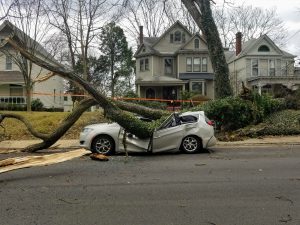
Emergency Tree Removal in Louisville
High winds and torrential rains ripped through Louisville and the surrounding areas this summer, leaving some trees uprooted and others with fallen limbs. Some branches that broke off or split dangled in mid-air, posing a danger to any that ventured near. Of course, those trees that uprooted were most likely to have been along sidewalks, often a sure guarantee of insufficient root mass to withstand the winds that shook the above ground pillars. Perhaps their root systems had previously been damaged or compromised by construction in the area. Those trees that lost branches rid themselves of many dead or dying stems or had defects in the unions of branch to main trunk and/or were damaged by internal decay or insects. (Consensus from arborists regarding the storms is that they were “cleansing storms,” in that they removed many dead, damaged, or diseased limbs.) For the loss of that uprooted tree, this is a wonderful opportunity to plant a tree that is more suited to its area. If it is a street tree, there are several species that will be more adapted to the rigors of soil compaction, salt spray, and regular trimming. If you are looking to replace a lost tree, there are many factors to take into consideration—size and spread, sun needs, deciduous versus evergreen, size of the leaves, does it have any fall color, does it bloom in the spring— and these can all be discussed with a reputable landscape designer, landscape architect, or a certified arborist.
What To Do After Tree Damage In Louisville?
For those trees that lost branches in the storm, we like to recommend remedial care in the form of a fertilizing in the dormant season (November—March). When a tree loses branches in a storm, it exerts a large amount of energy in closing off the wounds and redirecting nutrients and water elsewhere throughout the tree. To assist the tree, adding these nutrients into the soil 8”-10” below ground into the areas where the majority of the tree roots reside will help the tree recover from its loss of limbs and encourage new and healthy growth. Adding nutrients and water to the root layer also is beneficial for the roots, as they use what they need and then store for future use whatever the tree does not need at that time. For those older, mature trees, it is always good management practice to have them evaluated. Our certified arborists will help to assess any branch unions that are suspect and whether those trees would benefit from a fertilizing program, or if any of the branches need cabling (support) or removal of the tree would be necessary. Our highly trained team is standing by 24/7 to take on your emergency tree service.



